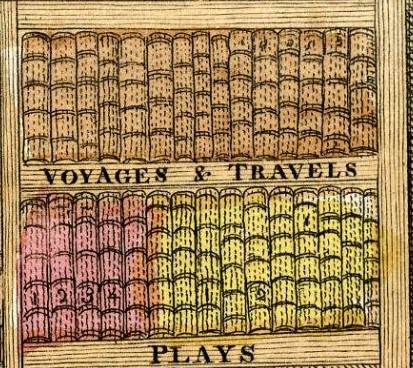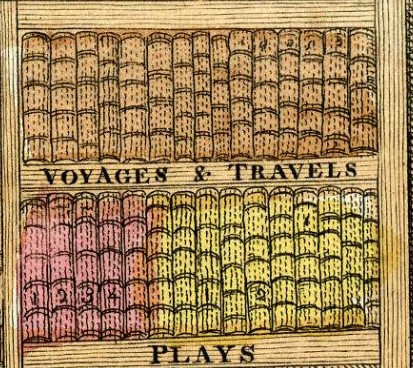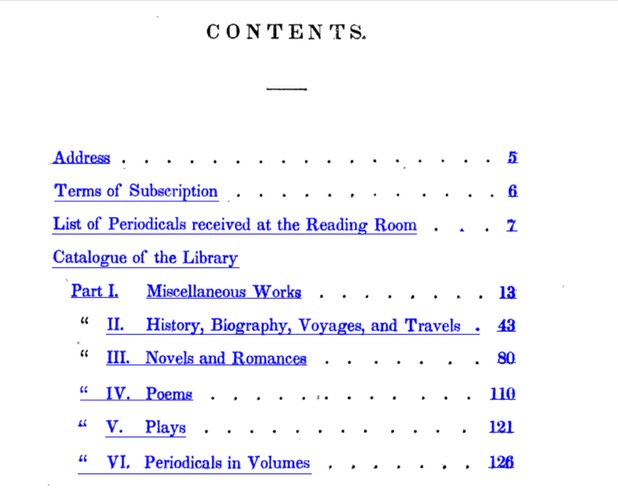This post is part of our By Our Books: Bibliography in the WPHP Spotlight Series, which will run through July 2023. This series attends to the bibliographical fields of the WPHP title records, tracing the history of our thinking about our descriptive practices and how they are informed by the sources available to us and by our feminist ambition to recognize and reconstruct women’s labour in print, broadly conceived.
Authored by: Isabelle Burrows
Edited by: Michelle Levy
Submitted on: 07/17/2023
Citation: Burrows, Isabelle. "Making Genre-alizations: Genre Designations in the WPHP." The Women’s Print History Project, 17 July 2023, https://womensprinthistoryproject.com/blog/post/125.
Figure. 1. Detail from “The Circulating Library,” published by Laurie & Whittle, 1804. © The Trustees of the British Museum.
Genre is one of the fields used in WPHP metadata to describe a book’s intellectual content rather than its features as an object. Along with the title, which often helps us to identify a book’s contents at a glance, the genre field is the place where our data describes a book’s contents and purpose. The authors whose works our data describes wrote in varied genres, from Juvenile Literature (our most populated genre category, with 3888 titles) to Poetry Dramatic (our least populated genre category, at just seven titles).
As our genre attribution system stands, we assign one genre per title from our list based on features of a book like title, preface, and chapters or verses which inform a research assistant’s assessment of that book’s genre. We briefly allowed multiple genre designations per title but found that complicated the genre issue as much as resolved it. So many titles can occupy two, three, or more genres, that to list every possible genre association would render the process of distinguishing titles by genre futile. The folks at Books and Borrowing: An Analysis of Scottish Borrowers’ Registers, 1750-1830 discuss their own genre challenges with multiple genre labels in a blog post, while the WPHP’s own Kate Moffatt, Tamanna T., and Michelle Levy dive further into the problem in their spotlight, which uses the work of Anna Letitia Barbauld as a case study.
Given the 31 diverse categories we offer as options in the WPHP's genre list, it might seem a simple task to attribute the right genre description to a work. Nevertheless, genre is one of the WPHP’s most hotly-debated data fields because, while other data fields such as Format or Volume are objective assessments of an item, genre is a subjective interpretation which compresses information into a single category. The process of selecting a single genre is further complicated by the ambiguity of genre labels during the eighteenth century (a period in which genres were themselves being formulated), and by the unresolved debate between form and subject—both of which our genre labels must attempt to capture.
Figure 2. List of genres available at the Parthenon Circulating Library and Reading Rooms in New York. From the 1834 Catalogue of the Parthenon Circulating Library and Reading Rooms by Charles Francis.
Our genre list comprises one group of descriptors which emphasize form (Letters, Works, and Poetry, for example); one group which emphasizes subject (such as Science/Natural History/Medicine or Religion/Biblical); and another group which confounds this division entirely (Education, for example, is neither a form nor a subject, but an indicator of a work’s purpose, and may include works that have little in common with one another in form or subject). Fiction, as a category, further complicates the designation process, as it takes into account not only our assessment of a book’s contents, but also the author’s intended categorization of their work based on their chosen title (as with Fiction Romance, a label only applied to books whose titles include the word Romance).
The genre question is underlined when the WPHP collaborates with other databases who treat genre differently, as when we added relevant data from The Drawing Book Project. As the name suggests, this is a catalogue created to prioritize a subject genre: art. The WPHP genre list has no specific genre label for books about art; therefore, when adding TDBP titles, we had to categorize such books using form-specific genre labels like Essays, for books of art criticism, or adjacent subject labels like Science/ Natural History/Medicine, for botanical illustration books, even though a researcher looking through the WPHP for books about art might prefer a subject heading for Art rather than the far broader genre category Essays.
Given the complexity of ideas that unfold within the pages of a book, it is currently possible only to provide an accurate, rather than a comprehensive, genre designation. Stay tuned, however, as our genre category is due for a revision which may amalgamate some of our less populated categories and attempt to separate out the subjects from the genres. It remains to be seen, however, whether this revision will lead to a resolution, or to many more complications.
WPHP Records Referenced
Juvenile Literature (genre)
Poetry Dramatic (genre)
Genre (field)
Anna Letitia Barbauld (person)
Letters (genre)
Works (genre)
Poetry (genre)
Science/Natural History/Medicine (genre)
Religion/Biblical (genre)
Education (genre)
Fiction (genre)
Fiction Romance (genre)
The Drawing Book Project (source)
Further Reading
Moffatt, Kate, Michelle Levy, and Tamanna T. "Anna Letitia Barbauld’s Writing and the Problem of Genre." The Women's Print History Project, 1 April 2022, https://womensprinthistoryproject.com/blog/post/104.
Sangster, Matt. "Some Notes on Book Hierarchies and Genre Classification." Books and Borrowing 1750-1830: An Analysis of Scottish Borrowers' Registers, 12 June 2023, https://borrowing.stir.ac.uk/some-notes-on-book-hierarchies-and-genre-classification/.


